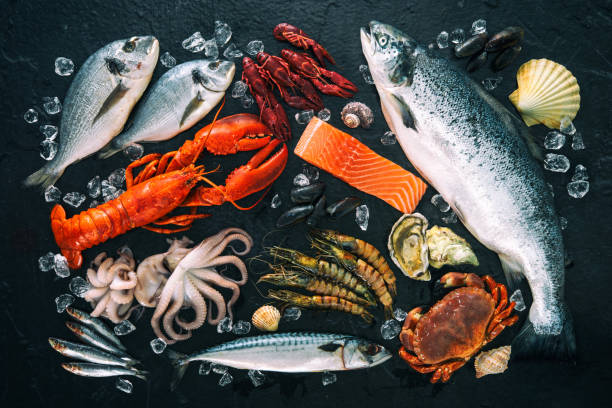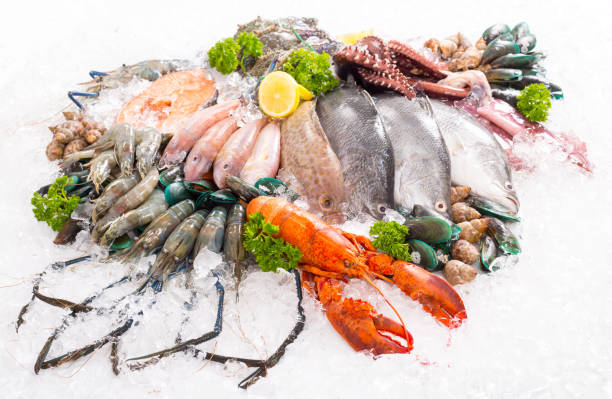Managing diabetes doesn’t mean you have to stop eating the foods you enjoy. In fact, seafood is a smart and healthy option for people with diabetes. It’s rich in essential nutrients, provides a good source of lean protein, and contains very little unhealthy fat. Eating fish like salmon, tuna, or shrimp can support blood sugar control while offering delicious variety in your meals.
In this article, we’ll look at why seafood is a smart choice for people with diabetes, highlight the best types to eat, and share tips on how to enjoy them as part of a healthy, balanced diet.
Why Seafood is Good for People with Diabetes
Seafood is more than just a delicious meal—it’s also packed with health benefits. For people managing blood sugar levels, seafood can be a great addition to the diet. It’s low in carbs, high in protein, and rich in important nutrients. Here’s why choosing seafood is a smart move:
High in Lean Protein
Protein plays a key role in managing blood sugar because it slows down digestion and helps prevent spikes. Seafood is a great source of high-quality protein and has less saturated fat compared to red meat, making it a healthier choice for people with diabetes.
Rich in Omega-3 Fatty Acids
Fatty fish such as salmon, sardines, and mackerel are loaded with omega-3 fatty acids. These healthy fats help lower inflammation, reduce triglyceride levels, and support heart health. For people with diabetes, this is especially important, since they have a higher risk of heart disease.
The American Diabetes Association states that omega-3 fatty acids may help lower the risk of heart disease. This is important because people with diabetes are more likely to face heart-related problems. Adding omega-3s to your diet can support better heart health over time. (source)
Low in Carbohydrates
Most seafood is naturally low in carbohydrates, which makes it a smart choice for managing blood sugar levels. Eating low-carb foods like fish can help prevent spikes and keep glucose levels steady throughout the day.

Best Types of Seafood for Diabetes
Not all seafood offers the same health benefits. Some types are better for managing blood sugar and supporting overall health. Choosing the right kinds of fish can make a big difference. Here are the best types to enjoy:
Fatty Fish
These are rich in omega-3s and include:
- Salmon is a popular low-mercury fish that is rich in healthy omega-3 fats and protein, making it a great choice for a nutritious meal.
- Mackerel is a flavorful fish that is low in mercury and high in healthy omega-3 fats. It’s a smart choice to include in a balanced diet.
- Sardines are small fish that are low in mercury and full of healthy omega-3 fats and calcium. They make a great, nutritious addition to your meals.
- Tuna is a popular fish that is high in protein and omega-3 fats. However, some types of tuna have more mercury, so it’s best to eat it in moderation.
Shellfish
Shellfish are low in fat and carbs. Good options include:
- Shrimp is a low-calorie seafood that is high in protein and low in mercury. It’s a healthy and tasty choice to include in your diet.
- Crab is a delicious seafood option that is low in fat and high in protein. It’s also low in mercury, making it a healthy choice for your meals.
- Lobster is a tasty seafood choice that is rich in protein and low in mercury. It can be a healthy addition to your diet when enjoyed in moderation.
- Clams are small shellfish that are low in fat and calories. They provide good protein and important minerals, making them a healthy seafood choice.
White Fish
White fish are lean, mild in flavor, and easy to cook. Try:
- Cod is a mild-flavored white fish that is low in fat and mercury. It is a good source of protein and works well in many healthy recipes.
- Haddock is a white fish with a mild taste. It is low in fat and mercury and high in protein, making it a healthy choice for your meals.
- Halibut is a firm white fish that is low in fat and mercury. It is rich in protein and makes a healthy and tasty addition to your diet.
- Tilapia is a mild-flavored fish that is low in mercury and fat. It is a good source of protein and works well in many healthy meals.
How to Cook Seafood for a Diabetes-Friendly Diet
How you prepare your seafood is just as important as the type you choose. Healthy cooking methods can help you get the most nutrition without adding extra fat or calories. Here are some simple tips to keep your seafood dishes healthy:
Best Cooking Methods
- Grilling
- Baking
- Steaming
- Broiling
These methods use little to no added fat.
Avoid These
- Deep frying
- Heavy sauces
- Breading with white flour
These add extra calories and carbs, which can spike blood sugar.
Seafood Meal Ideas for People with Diabetes
Need some meal ideas? Here are a few simple and diabetes-friendly seafood recipes you can try at home to keep your diet tasty and healthy:
Grilled Salmon with Vegetables
Try serving salmon alongside steamed broccoli and colorful bell peppers. Finish with a fresh squeeze of lemon for added flavor and nutrition.
Shrimp Stir-Fry
Cook with olive oil and garlic to add healthy fats and flavor. Include plenty of colorful vegetables, and serve your dish over a small portion of brown rice or quinoa for a balanced meal.
Baked Cod with Herbs
Add fresh parsley, thyme, and a splash of lemon juice to brighten the flavor. Pair your seafood with a side salad or roasted Brussels sprouts for a healthy, well-rounded meal.
How Much Seafood Should You Eat?
The American Heart Association suggests eating at least two servings of fish each week. One serving equals about 3.5 ounces of cooked fish, which helps support heart health and overall wellness.
Follow this recommended amount unless your doctor advises a different plan. Eating different types of fish can provide a wide range of important nutrients to support your health.

Things to Watch Out For
Seafood is a healthy food choice, but there are some important things to keep in mind before you add it to your diet:
Mercury Content
Some kinds of fish have high amounts of mercury, which can be harmful if you eat them too often. It’s best to limit fish such as:
- Shark
- Swordfish
- King mackerel
- Tilefish
Instead, pick low-mercury fish like salmon, cod, or tilapia. These choices are safer and better for your health.
Sodium Levels
Some canned or processed seafood may contain a lot of sodium, which can affect blood pressure and health. Always check the nutrition labels before buying, and rinse canned fish with water to help lower the salt content.
Allergies
If you have a seafood allergy, it’s important to talk with your doctor before trying any new types of fish or shellfish. This can help you avoid allergic reactions and stay safe while enjoying healthy meals.
Can People with Diabetes Eat Sushi?
Sushi can be a healthy meal, but its benefits rely on the ingredients you choose. To enjoy sushi safely and make it diabetes-friendly, follow these simple and helpful tips:
- Opt for sushi rolls that include fresh fish and a variety of vegetables for a healthy and tasty choice.
- Avoid tempura rolls, as they are fried and contain extra calories and fat.
- Ask for brown rice instead of white rice when it’s available for a healthier sushi option.
- Limit how much soy sauce you use because it has a lot of sodium, which is not good for your health.
Sashimi, which is thinly sliced raw fish served without rice, is a great low-carb option. It’s a healthy way to enjoy fresh seafood while helping to keep your blood sugar steady.
Nutritional Benefits of Seafood for Diabetics
Here’s a look at the important nutrients and health benefits that seafood provides:
- Protein: Keeps you feeling full longer and helps control blood sugar levels throughout the day.
- Omega-3s: Help protect your heart and boost brain health by reducing inflammation and supporting cell function.
- Vitamins and Minerals: Seafood provides important nutrients like vitamin D, vitamin B12, iodine, and selenium that support overall health.
These nutrients play a key role in lowering the risk of complications related to diabetes and help support better overall health.
Expert Opinions and Research
Many studies show that seafood offers health benefits for people with diabetes. For example, research published in the journal Nutrients found that eating fish regularly was linked to lower fasting blood sugar and better insulin sensitivity. (source)
Groups like the American Diabetes Association and the U.S. Food and Drug Administration recommend including seafood in a healthy diet. They highlight its benefits for managing blood sugar and supporting overall wellness.

Tips for Adding More Seafood to Your Diet
Looking to add more seafood to your meals? Here are some easy ways to get started and enjoy its health benefits:
- Try adding a different type of fish to your meals each week to enjoy variety and get a range of nutrients.
- Add canned tuna or salmon to your salads for a quick, easy way to boost protein and healthy fats.
- Try making fish tacos using grilled fillets topped with fresh salsa for a tasty and diabetes-friendly meal.
- Keep frozen fish in your freezer for easy, quick meals whenever you need a healthy seafood option.
Conclusion: Seafood is a Smart Choice for Diabetes
Seafood is a delicious and nutritious choice that is safe for people with diabetes. It provides lean protein, healthy fats, and many important nutrients that support good health. Just be sure to pick the right kinds of seafood and prepare them using healthy cooking methods.
By including seafood regularly in your diet, you can enjoy tasty meals while supporting better overall health and managing your diabetes more effectively.
Ready to eat more seafood? Share your favorite seafood recipes or any questions you have in the comments below. Together, we can support each other on the path to healthier living!

